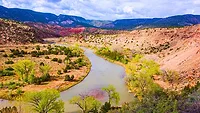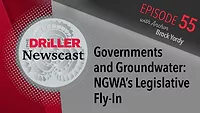Legislative Update
Legislation To Assist Low-Income Well Owners Introduced In Congress
US Sen Rick Santorum, R-PA, has introduced legislation in Congress to aid private well owners by allowing the federal government to join with non-profit organizations to help low-and moderate-income households build, refurbish or service their wells.The proposed legislation, titled the Affordable Drinking Water Act of 2000, is supported by the National Ground Water Association (NGWA) and the Water Quality Association (WQA).
A companion measure, House Resolution 3910, was introduced earlier by Rep John Boehner, R-OH, in the US House of Representatives. This bill would amend the Consolidated Farm and Rural Development Act to allow the Secretary of Agriculture to make grants to non-profit groups for well construction and repair work in rural areas.
The proposed legislation, which was referred to the Senate Agriculture, Nutrition and Forestry Committee, states approximately 15 million households in the US receive drinking water from household well systems and more than 80% of those well owners prefer water from the wells to a community water system or bottled water.
Noting many of the wells are not built to current standards and should be upgraded to ensure access to the safest and most reliable water supply, the legislation states the Department of Agriculture (DOA) doesn't have a program focused on funding construction or repair of individually-owned wells.
Persons eligible to receive the grants would have a total household income below the median non-metropolitan household level for the state where the residence is located.
EPA Plans To Ban Toxic Mixing Zones In Great Lakes
The Environmental Protection Agency (EPA) has taken action to finalize a rule banning up to 700,000 toxic pounds of chemicals that are discharged into the Great Lakes each year and accumulate in fish and wildlife.Mercury discharges will be reduced up to 90%. The rule specifically bans discharge of 22 toxic chemicals including dioxin, PCBs and pesticides through mixing zones. The mixing zones are areas where toxic chemicals are disposed of in certain areas of waterways under the theory their dilution in surrounding water justifies less protective discharge standards in the mixing zone.
The EPA has committed to develop a national regulation for mixing zones in 2001 based on the action in the Great Lakes.
For more information, visit http://www.epa.gov/ost/mixingzones/index.html.
USGS Receives Budget Increase
The US Geological Survey (USGS) has received a $72 million net increase in funding for the 2001 Fiscal Year in the Interior Appropriations Bill approved by Congress and signed by President Bill Clinton.USGS Director Charles Groat said with the increase they will receive $885 million for the current fiscal year. The additional funds will enable the agency to expand and modernize its earthquake monitoring network in urban areas, enhance capabilities to monitor quality of groundwater systems, expand its network of real-time stream gauges, and add an additional high-risk Alaskan volcano to its hazards monitoring network.
He added the funds also will enable the agency to increase funding for geologic mapping, coastal and marine geology studies, the National Atlas, amphibian research and monitoring, biological information systems, the mission operations of Landsat 7, and funding for high-priority research in support of Department of the Interior land conservation and preservation.
Well Restrictions Set In New Mexico
New state regulations in New Mexico are posing problems for anyone seeking to drill a water well in the middle Rio Grande basin area.The new rules require anyone who wants to drill a new well in sites where groundwater levels are rapidly dropping to install a meter. Previously the only requirement to drill a well was payment of a $5 appllication fee.
The only area currently affected by the new regulations is an area in the northeastern section of Albuquerque, but other areas could be added later.
Another provision of the new regulations provides permits will only be issued to water users for the amount of water they say they will require for the next 40 years.
The new regiulations were put into effect by New Mexico State Engineer Tom Turney.
EPA Launches New Web Site
A new Web site has been launched for the US Environmental Protection Agency's (EPA) Office of Ground Water and Drinking Water source water program. The new site will offer access to source water information, assessments, questions, and other Internet water-related resources.
The new Web site can be accessed at www.epa.gov/safewater/protect.html.
Links
Looking for a reprint of this article?
From high-res PDFs to custom plaques, order your copy today!




